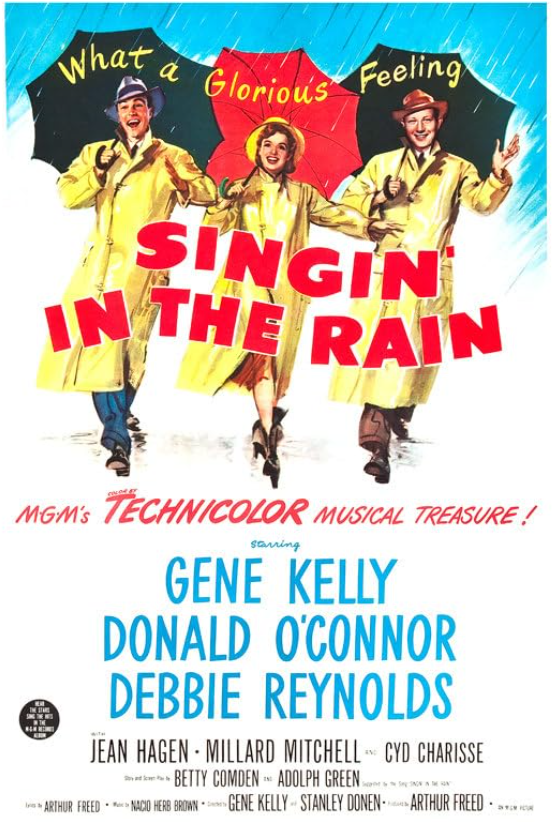This time around in our continued quest through the featured Letterboxd Lists we have a selection off of a list of great movies. But it isn’t just any list, it’s the Roger Ebert’s “Great Movies” list, which includes every movie from his essays of the same name. So, on a list that totals 378 movies, which one are we tackling today? Well, that just so happens to be…Singin’ in the Rain (1952).
Title: Singin’ in the Rain
Director(s): Stanley Donen and Gene Kelly
Runtime: 1 hour 43 minutes
Released: April 10, 1952
Available to stream on: MAX

Don Lockwood (Gene Kelly) and Lina Lamont (Jean Hagen) are at the top of their game and rule the silent era of Hollywood. However, it isn’t all sunshine and rainbows. In fact, Lockwood and Lamont secretly can’t stand each other.
On the red carpet of their newest release, Don Lockwood takes us down memory lane and gives us all a look at his start in the business. What he tells the press and how he actually got his start are two very different stories. He and his best friend, Cosmo Brown (Donald O’Connor), actually were stuntmen and vaudeville musicians before becoming established.
We cut back to present day after the premiere and Lockwood, fleeing his fans, hops into a car driven by Kathy Selden (Debbie Reynolds). Kathy agrees to drive Lockwood to the after party for his premiere. While at the after party, the head of Monumental Pictures, R.F. Simpson (Millard Mitchell), shows everyone a brief peek at what talking pictures will look like. Most of the people in attendance scoff and the party continues. It isn’t until later on in the night that Lockwood discovers that Kathy Selden is part of the chorus group of girls hired to perform at the after party.
After Warner Bros. releases their talking picture, The Jazz Singer, R.F. Simpson decides to pivot and make the newest Lockwood and Lamont picture, The Dueling Cavalier, a talkie as well. The shift from silent films to talking pictures is one of gigantic proportions. The audiences will now hear the voices of the big screen stars for the first time on screen.
Thus, Lockwood and Lamont both begin taking lessons from a diction coach to help them annunciate their words. As the lessons progress, and Lamont is not progressing as hoped, Lockwood begins to formulate an idea.
What if there were someone who could sing the parts for Lina Lamont? It would still be Lina that everyone in the theaters sees, just that her voice would become more palatable.
But will Don Lockwood’s latest scheme completely dismantle what is left of a working relationship with Lina Lamont?

Prior to this viewing, Singin’ in the Rain (1952) was a giant blind spot for me. Yes, I’ve seen the iconic dance number. And yes, I knew of some of the other musical numbers. But I’d never sat and watched the movie from beginning to end.
One of the first things that jumped out to me was the bright vibrant colors. Everything is bold and pops without being in your face or overwhelming. Another thing that is nearly impossible to ignore is the talent on display in the dance numbers. Debbie Reynolds, in her big breakout, holds her own with the like of Gene Kelly and Donald O’Connor. In fact, overall, the majority of the songs feel natural and not like they were shoehorned in just because the movie is a musical.
This isn’t a slight on the abilities of either Reynolds or Kelly, but I found myself to be more captivated by O’Connor when he was on the screen. I can’t quite put my finger on it, but something about his performance managed to steal the spotlight. That being said, it should come as no surprise that my favorite number was “Make ‘Em Laugh”.
Meanwhile, the story of transitioning from silent films to talkies was incredibly well done. We see the impact it has on audiences, the studios, and more importantly on the individual talent themselves. If you happen to be like me and hadn’t yet seen Singin’ in the Rain (1952) but were fond of The Artist (2011), you’ll be in for a treat.
And if you’ve already seen Singin’ in the Rain (1952), well, now is as good a time as any to watch it again.
So, you’ve heard my thoughts, but now it’s time for yours.
If you’ve seen Singin’ in the Rain (1952), leave a comment below or reach out on social media and tell me what your thoughts are.
As always, you can follow me over on Letterboxd to keep up on everything else I’ve been watching.
